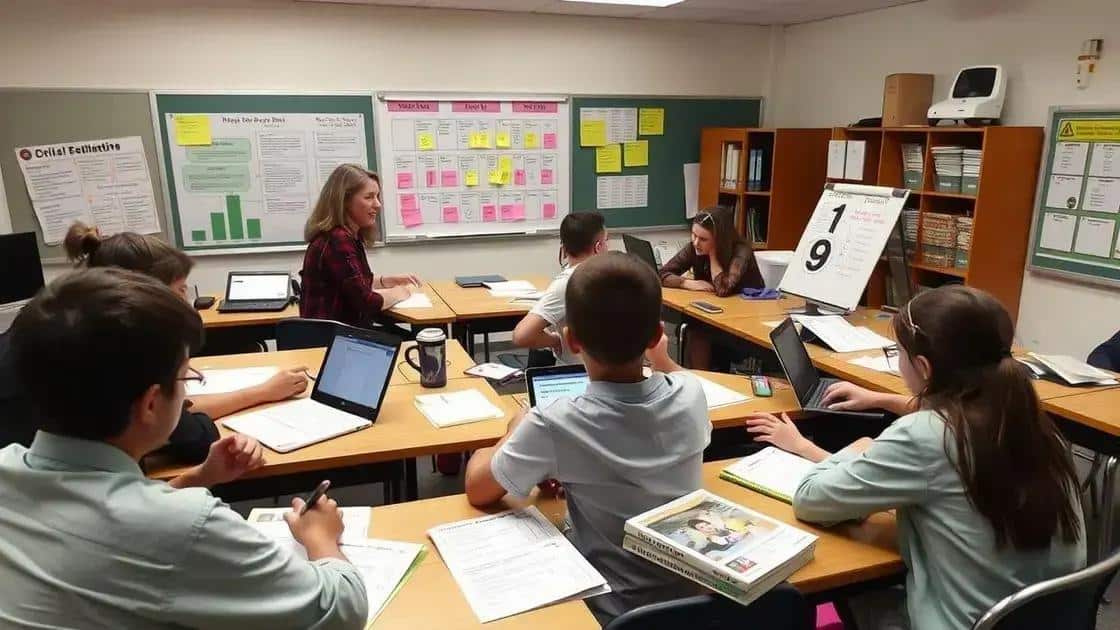Insights on digital literacy curriculum to improve education

Digital literacy initiatives enhance students’ abilities to use technology effectively, with assessments utilizing both qualitative and quantitative data to evaluate their impact on learning outcomes.
Insights on digital literacy curriculum can significantly shape how students engage with technology. Have you considered how essential digital skills are today? Let’s dive deeper into the elements that can enhance learning.
Understanding digital literacy: more than just tech skills
When we talk about digital literacy, we are referencing a vital set of skills that go beyond simply knowing how to use technology. Understanding digital literacy encompasses the ability to find, evaluate, and communicate information effectively using digital platforms.
Key Aspects of Digital Literacy
To grasp the full essence of digital literacy, let’s explore its main components:
- Critical thinking skills for evaluating online information.
- Communication techniques tailored for digital environments.
- Understanding online safety and privacy issues.
These elements highlight that digital literacy is not just about using tools; it’s also about navigating the digital landscape wisely. Educational programs focusing on digital literacy empower students to become more than just consumers of information. They encourage them to be critical thinkers and responsible digital citizens.
The Importance of Communication Skills
Effective communication is a cornerstone of digital literacy. This includes understanding how to express ideas clearly in various formats, whether it’s through emails, social media posts, or multimedia presentations. Being able to communicate effectively online also includes recognizing the cultural nuances and varying contexts of different digital platforms.
Students equipped with these skills are able to articulate their thoughts and collaborate better in a diverse, interconnected world. As technology continues to evolve, so do the methods of communication. Therefore, teaching these skills is crucial for preparing students for future challenges.
Key components of a successful digital literacy curriculum

Building a successful digital literacy curriculum involves integrating several key components that ensure students gain the necessary skills for today’s digital world. These components work together to create a holistic learning experience.
Curriculum Goals
One of the first steps is establishing clear objectives. A well-defined set of goals outlines what students should know and be able to do by the end of the program. This includes:
- Understanding basic digital tools.
- Developing critical thinking skills.
- Learning to communicate effectively online.
By clearly defining these goals, educators can tailor their lessons to meet the needs of their students, ensuring that each learner can progress at their own pace.
Practical Applications
Hands-on activities are another essential element. Engaging students in real-world projects encourages them to apply what they’ve learned. For example, students could design a website or create a presentation using various digital tools. These tasks help reinforce skills and improve their confidence in using technology.
Moreover, practical applications allow students to see the relevance of their lessons, making learning more engaging. Incorporating collaborative projects can also foster teamwork and improve communication skills.
Regular assessments are crucial to monitor progress. This helps educators determine which areas students excel in and where they need additional support. Combining formative and summative assessments ensures a comprehensive understanding of the learners’ skills.
The role of educators in facilitating digital learning
Educators play a crucial role in facilitating digital learning as they guide students through the complexities of technology and digital information. Their influence can significantly affect how students interact with digital tools and resources.
Creating a Supportive Environment
One important aspect is creating a supportive environment that encourages exploration and learning. Educators should foster a space where students feel safe to ask questions and make mistakes. This open environment helps students build confidence in using technology. Additionally, they can use various teaching strategies to engage all types of learners.
- Incorporate interactive lessons that involve technology.
- Use diverse resources to cater to different learning styles.
- Encourage collaboration among students to enhance problem-solving skills.
By using different methods, educators ensure every student can engage with the material, which is vital for a successful digital literacy curriculum.
Supporting Continuous Learning
Moreover, educators guide students in developing a growth mindset toward technology. They can teach students how to seek help and continue learning outside the classroom, which empowers learners to become independent. This includes showing students how to use online resources effectively, such as educational platforms and tutorials.
Additionally, educators must stay updated with the latest technology trends and tools. By participating in professional development, they can discover new ways to integrate technology into their teaching. This continuous learning process is beneficial not only for teachers but also for students, as it enriches the learning experience.
Assessing the impact of digital literacy initiatives

Assessing the impact of digital literacy initiatives is essential to understand how well these programs are working. By gathering data and feedback, educators can make informed decisions that enhance student learning.
Qualitative and Quantitative Measures
To effectively assess the impact, it’s important to use both qualitative and quantitative measures. Quantitative data includes test scores and metrics that show improvement in skills. Qualitative data, on the other hand, can come from surveys and interviews that capture student experiences.
- Test scores can indicate how well students grasp digital concepts.
- Surveys can reveal how confident students feel about using technology.
- Observations in classrooms can provide insight into student engagement.
Using a mix of these methods allows educators to paint a complete picture of the program’s success. This dual approach helps highlight areas that are working well and those needing improvement.
Setting Clear Objectives
Establishing clear objectives before initiating the program will help in the assessment phase. When educators know what they aim to achieve, they can measure against those specific goals. For instance, if a goal is to improve online research skills, assessing students’ research projects before and after implementing the digital literacy curriculum can show progress.
Continually monitoring student progress is vital. Regular assessments not only provide insight but also allow for adjustments to the curriculum as needed. This helps ensure that all students benefit effectively from digital literacy instruction.
In summary, assessing the impact of digital literacy initiatives is crucial for enhancing educational programs. By collecting both quantitative and qualitative data, educators can better understand how these initiatives shape student learning. Setting clear objectives helps in measuring progress effectively. The role of educators in fostering a supportive learning environment further boosts student engagement. With ongoing evaluation, schools can create a responsive curriculum that meets the needs of all learners, preparing them for a technology-driven future.
\n
| 🏆 Key Takeaways | 💡 Insight |
|---|---|
| Data Assessment | Using both qualitative and quantitative data helps evaluate the effectiveness of digital programs. |
| Goal Setting | Establishing clear objectives allows for effective measurement and monitoring of progress. |
| Supportive Environment | A positive classroom atmosphere encourages exploration and engagement with technology. |
| Continuous Learning | Professional development for educators enhances their ability to teach digital literacy. |
| Program Improvement | Regular evaluation allows for curriculum adjustments to better meet student needs. |
\n
FAQ – Frequently Asked Questions about Digital Literacy Initiatives
What are digital literacy initiatives?
Digital literacy initiatives aim to improve students’ abilities to use technology effectively and responsibly in their learning environment.
How can the impact of these initiatives be assessed?
The impact can be assessed through a combination of quantitative data, like test scores, and qualitative feedback, such as student surveys.
What role do educators play in digital literacy?
Educators create a supportive learning environment and guide students in using technology while continually adapting their teaching methods.
Why is continuous assessment important in a digital literacy program?
Continuous assessment helps identify both strengths and areas that need improvement in student skills, allowing for responsive curriculum adjustments.





